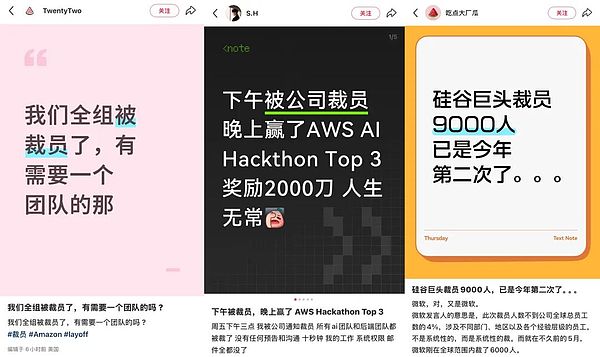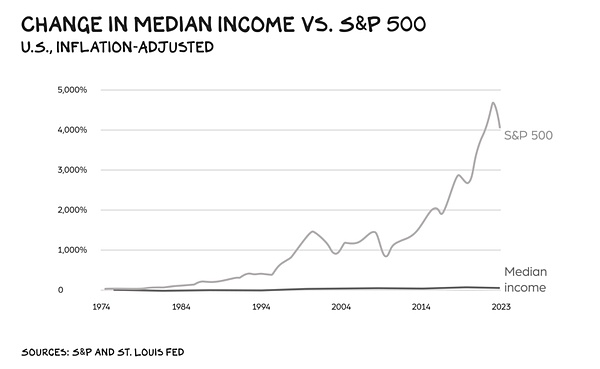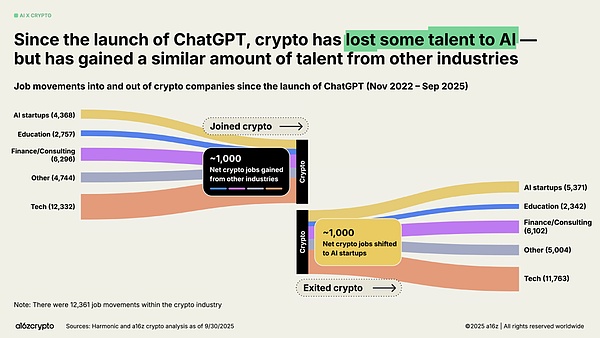
Author: Sleepy.txt

This fall in the technology industry has been particularly cold.
On October 28, Amazon announced plans to cut as many as 30,000 corporate jobs, accounting for nearly 10% of the company’s total employees. This is the largest layoff since the end of 2022.CEO Andy Jassy said the company will replace some jobs with AI.
Paycom, an American human resources software company, also laid off more than 500 employees at the beginning of the month, and their positions will be replaced by “AI and automation.”A month ago, Just Eat Takeaway, Europe’s largest food delivery company, announced it would lay off 450 people, citing “the use of automation and AI.”Push forward half a month, the freelance platform Fiverr laid off 30% of the company’s total headcount at one time, and the CEO said that he wanted to become an “AI native company.”In addition, Meta, Google, Microsoft, and Intel have also successively tightened their manpower.
Those being laid off are not assembly line workers, but professional positions that require high education, years of experience, and layers of interviews to enter, including software engineers, data analysts, product managers, etc.For a long time in the past, they have believed that skills are a moat, educational experience is insurance, and hard work will eventually bring rewards.
Hundreds of thousands of tech workers have lost their jobs this year, according to TrueUp, a website that tracks layoffs in the tech industry.The impact of AI does not start with low-skilled jobs. It will first shake up those mental jobs that are considered the safest and have the most professional barriers.
What’s even more cruel is that this replacement process is not gradual.AI won’t replace first 10% of jobs, then 20%, then 30%; rather, at some tipping point, entire departments will be eliminated.

The essence of labor is to exchange time for money.Time is inherently limited, and the biggest risk of this system lies in its continuity. Once labor is forced to be interrupted, whether due to unemployment, illness, or aging, income will also be interrupted immediately.This is a common situation that all people who sell their time for income will eventually face.
Stalling wages, rushing assets
In April 2024, Scott Galloway, a professor at New York University’s Stern School of Business, published an article titled “War on the Young>”.It writes that from 1974 to 2024, real median wages in the United States increased by 40%, while the S&P 500 index rose by 4,000% during the same period.A full hundred times difference.
This means that if you had $10,000 in 1974 and invested it in the S&P 500, it would be $400,000 in 2024.But if you started working in 1974 and saved little by little from your paycheck, by 2024 you would be able to buy only 40% more than you did back then.

Research from the Center for Equitable Growth, a Washington think tank, further supports this trend.As we enter the twenty-first century, wage growth has lagged behind nearly all other sources of income.Capital gains, dividends, and interest, income that does not require you to clock in and go to work every day, are growing much faster than wages.
This gap has already penetrated into everyone’s daily life.
In 1985, the median house price in the United States was $82,800, the median annual household income was $23,600, and house prices were approximately 3.5 times income.Forty years later, house prices have risen to $416,900, but income has only risen to $83,150, and the ratio of house prices to income has been stretched to five times.

Comparison of median income, house prices and loan interest rates in the United States in 1985 and 2025|Source: Visual Capitalist
In the San Francisco Bay Area, where home prices have risen far faster than the national average, tech workers’ income growth has been relatively limited.An engineer who joined Google in 2015, with an annual salary of more than 100,000 U.S. dollars at the time, was eyeing a two-bedroom apartment in southern Silicon Valley worth about 2 million U.S. dollars.He thought that as long as he worked for a few more years and saved enough for a down payment, he would be able to afford it.Five years later, his salary has increased and housing prices have risen even faster.That house became 3 million; by 2025, it was approaching 4 million.
Wages have less than doubled, but housing prices have almost doubled.Ten years later, he was further away from that house.
From the beginning of 2021 to mid-2025, U.S. consumer prices increased by a cumulative 22.7%, and average hourly wages increased by 21.8%.On paper, your salary is rising, but when converted into cost of living, you can buy fewer things.
This is where the confusion lies for many working-class people. For them, the growth of wealth can almost never keep up with the growth of life.Wages are rising, as are rent, electricity bills, and child care expenses.In the United States, the top 10 percent of workers earn five times as much as the bottom 50 percent, according to the World Inequality Lab.But at the level of wealth, this gap is magnified to a hundred times.
The wage gap is only superficial. What really determines destiny is the capital gap.For most people, the accumulation of wealth depends on the investment of time; but for those who already own capital, time itself is the engine of wealth.When assets are appreciating and re-appreciating, no matter how fast workers chase them, it will be difficult to cross the ever-rising curve.
The middle class trapped in hallucinations
In the technology industry, this structural gap is particularly evident.
It was once a dream industry for workers.High salary, options, and a seemingly eternal promise that as long as you are smart enough and work hard enough, you can achieve financial freedom through your own labor.
This belief underpins an entire generation of the intellectual middle class and forms the core of the Silicon Valley narrative.But a wave of layoffs in 2025 has ripped open cracks in this narrative.
According to a report on high-income groups in North America released by the Boston Consulting Group in February this year, they surveyed thousands of people in Canada with annual incomes between $75,000 and $200,000. They are considered to be in the upper middle class or even the wealthy class.The results show that only 20% of people feel that they are financially secure, nearly one-third believe that their situation has become more unstable in the past year, and about 40% of people are worried about being laid off.
This anxiety is increasingly common among middle-class Americans.
According to a US media survey, nearly half of those with an annual income of more than $100,000 said they lived a “moonlight” life.An Amazon engineer working in Seattle makes $180,000 a year, which looks great, but he has to pay $4,000 a month in mortgage payments, $2,000 in child care, $1,000 in car payments and insurance, and $500 in student loans.After-tax income was about $11,000 and I was left with less than $1,000 in savings.
“I feel like I’m stuck on a treadmill and don’t dare to stop,” he said in an interview. “I don’t dare to change jobs because the new position may pay lower wages; I don’t dare to get sick because taking time off will affect my performance.”
This kind of anxiety shows that what people are really uneasy about is not the amount of income. High salary does not equal security.True financial security comes from passive income, income that does not depend on ongoing labor.As long as life is still tied to working hours, no matter how high the salary is, it will only provide temporary stability.
In addition to wages, stock options were once seen as the key to wealth for workers.It makes countless engineers, product managers, and designers believe that they are not only employees of the company, but also “co-owners” of the company.Every overtime job and every night when a product is launched seems to be contributing to future wealth accumulation.
But reality is biting back at this narrative.A product manager who had worked at Meta for three years discovered after being laid off that he still had half of the options in his hands that had not yet been unlocked, which were worth about $150,000 based on the stock price at the time.But because of resignation, all those options were voided.
“I always thought it was my asset,” he said, “but it’s just a tool the company uses to keep you. Once you leave, it’s nothing.”
Stock options appear to be allocations of capital, but in reality they are still delayed payments of labor.It postpones risks, puts hopes forward, and allows employees to extend their working hours under the illusion.
More and more technology practitioners are beginning to realize that security does not come from the level of wages, but from the proportion of capital in the personal income structure.They began to look for a path from “laborers” to “capital owners”.
Three roads, none of them easy to walk
The first way is to start a business.From selling your own time to buying other people’s time, from being an employee to being a boss.This is the most direct and difficult road.According to the U.S. Bureau of Labor Statistics, about 20 percent of startups fail in their first year, less than half survive five years, and less than 30 percent survive past ten years.And among those 30%, only a handful have truly achieved financial freedom.
The second path is delayed gratification.Followers of the FIRE (Financial Independence, Retire Early) movement believe that as long as they are disciplined enough to save most of their income and invest in assets that can bring stable returns, they can get rid of the shackles of work early.
Sounds like a rational choice – practice moderation, save, and let compound interest work for you.
But in cities like San Francisco and New York, if you want to save half of your annual salary in the reality of high rents and high prices, it almost means giving up socializing, traveling, and consumption.What’s even more difficult is that this kind of delayed gratification requires you to maintain a high income, not lose your job, not get sick, and not encounter accidents.If any variable goes wrong, the plan will be disrupted.
In addition to these two paths, many young people are beginning to look for new possibilities.
They are no longer satisfied with putting their money in bank accounts to earn interest, and they no longer rely solely on the company’s matching pension. They begin to actively learn asset allocation and let their money work on its own.
Millennials and Gen Z are the first to make widespread use of automated investing tools early in their careers, according to research.They prefer to manage their accounts themselves, and their investment directions are more diversified, ranging from stocks and bonds to index funds and even crypto assets.
The reason for this change is actually anxiety.
When high salary no longer equals security, when the wave of AI makes “stability” increasingly difficult, investment, a game that used to belong only to the rich and professional institutions, is being relearned and redefined by the young people of this era.
The most mainstream option is still to invest in traditional financial markets.For example, stocks, index funds, and real estate investment trusts (REITs) are another compromise for young people who cannot afford a house.Nareit data shows that the total market value of U.S. REITs will exceed $1.4 trillion in 2025.By purchasing REITs, people can indirectly hold part of commercial real estate with relatively small amounts of funds, share in the appreciation dividends of the real estate market, and also be considered as hedging against rising rents and housing prices.
But for many young people, these are still too slow.They grew up in the Internet era, are naturally close to new technologies, and are more able to withstand risks.In the pursuit of financial freedom, they began to turn their attention to a more radical field-cryptocurrency.
A16Z mentioned in a report released in October 2025 that since the advent of ChatGPT, there is still a large amount of talent flowing into the crypto world from traditional financial and technology companies.As artificial intelligence comes to the center of a new world, the crypto space continues to attract a group of people chasing uncertain opportunities.

For many tech workers, the crypto world offers a seemingly faster path.In a traditional company, they receive a salary and stock options that can only be vested when the company goes public or is acquired.
In Crypto projects, rewards are often issued in the form of Tokens. As long as the project goes online, these tokens can be traded in the secondary market, and their liquidity is much higher than that of traditional equity.That means more immediate incentives for those tired of waiting.
But Crypto is still a high-volatility gamble.The frequency of price surges and collapses far exceeds that of any traditional asset, and fluctuations of twenty to thirty percent in a single day have become the norm.This investment boom just illustrates how desperate the traditional path is.It is too difficult to start a business, FIRE is too slow, and the returns from traditional investments cannot keep up with the rise in asset prices, so people would rather choose a new area full of risks to keep betting. They are like a mirror, reflecting not greed, but anxiety.
The price of the new order
It all ends up converging on two curves.
Through the first three quarters of 2025, the S&P 500 is up 17% and the Nasdaq is up 22%, and those holding stocks are seeing their wealth grow.At the same time, real wages are falling and unemployment is rising.The two curves, one going up and one going down, are getting farther and farther apart.
This is no accident.When the growth rate of labor income cannot keep up with the cost of living, and when AI begins to threaten the stability of high-skilled jobs, people will naturally look for other sources of income – investment, speculation, gambling, and arbitrage.This anxiety is most obvious especially in emerging industries.
The question is, where will such a shift lead society as a whole?
If more and more people start to rely on investments, what about those without capital?A newly graduated college student has no savings and no family support. How can he get his first pot of gold?If the only way is to slowly accumulate wages, and the growth rate of wages is far less than the rise in asset prices, he will never catch up with those who are already at the starting line, which will lead to the solidification of classes.
Another question is, when AI continues to replace labor, to what extent will the total amount of human work be reduced?
In the future, AI and robots may replace most human jobs.This is not a short economic cycle. In this change, the meaning of labor, the source of income, and even the value of “effort” are being redefined.
Throughout history, humanity has faced similar moments.In the early days of the Industrial Revolution, machines replaced manual labor and a large number of textile workers became unemployed. The society was once plunged into chaos and anger.
But in the end, industrialization did not destroy labor, but reshaped it. New jobs were created, new industries emerged, and overall productivity and living standards were raised to a new level.The question is, will the same be true for the AI revolution?No one knows the answer.
The transformation of the Industrial Revolution took more than a century and was accompanied by countless social unrest, strikes and redistribution.And the speed of the AI revolution far exceeds that era.In less than three years since ChatGPT was released, it has changed the structure of the job market. When algorithms can write code, generate content, handle customer service, and formulate strategies, so-called “professional capabilities” are also being redefined.
Perhaps the end of labor is not the end of work, but the redistribution of the meaning of work.AI will not make humans completely unemployed, but it is rewriting the nature of “work” and the source of “security.”In the next ten years, this new distribution order will determine the shape of the economy and how individuals find their place and dignity in it.





